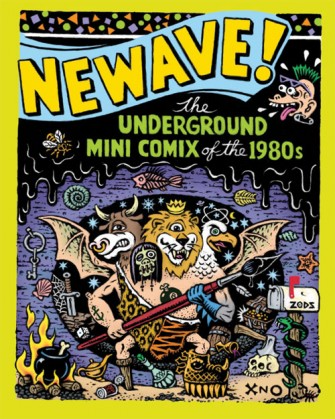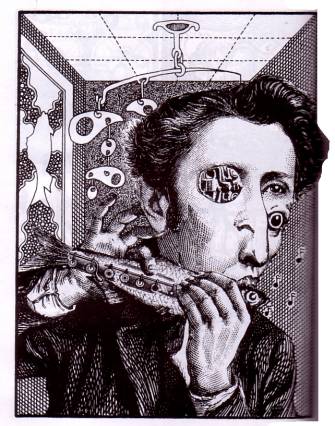 Home > CR Reviews
Home > CR Reviews Newave! The Underground Mini Comix Of The 1980s
posted February 4, 2010
Newave! The Underground Mini Comix Of The 1980s
posted February 4, 2010

 Creators:
Creators: Michael Dowers, Adam Grano and a Cast of Thousands
Publishing Information: Fantagraphics, Hardcover, 892 pages, February 2010, $24.99
Ordering Numbers: 1606993135 (ISBN10); 9781606993132 (ISBN13)
This is a fascinating book on a lot of levels. For one, it's distinguished by Adam Grano's design work to a degree I think noteworthy: on many levels,
Newave! represents better than any book I've seen the clash of comics publishing impulses now and then. Instead of the kind of standard presentation one might assume from an historical work,
Newave! is this thick,
filet mignon-sized book, its height and width an homage to the way many of the featured periodicals originally appeared, now in a hardcover work with fancy paper and at a page count that would have been impossible at the time. Grano presents the supporting material almost as if they were transferred directly from a typewritten sheet, but the comics themselves are generally immaculate reproductions rather than photos of the original work. The portraits used are dim and black and white in a way that flatter their subjects but also suggest a time that's gone now -- even as most of the artists are still with us. It says something about Grano's increasingly compelling body of work with Fantagraphics that he provides the work with much of the energy that helps the reader through nearly 900 pages.

It's Michael Dowers that makes that trip worthwhile. By avoiding a summary statement and roping in so many cartoonists, presenting 700 pages of their work in doing so (the size I'm guessing may have made the book more affordable to publish), Dowers lets the reader come to the material rather than shoving it into their face. His confidence is justified: a lot of these comics are fascinating-looking, and the sheer handsomeness of many of the pages, this wall of better-than-expected craft, will probably be the biggest shock to those that kind of dismissed this kind of work whenever one encountered it along the way. There are a bunch of feature cartoonists with whom most alt-comics fan will have some familiarity, and you do get the joy of seeing this side to the careers of people like Steve Willis and Mary Fleener and Rick Geary, to do your usual wondering after why JR Williams and Molly Kiely weren't bigger cartooning stars across various platforms. It's nice to see Dennis Worden's comics and be reminded now that you're older and know better what a natural cartoonist he is. It's a kick to see each of these folks in the context of their direct peers. And yet there are also comics I've never seen from cartoonists with whom I'm barely familiar. There's a comic called "White Boy Goes To Hell" by a cartoonist named Harry Lyrico that has a couple of story effects that are genuinely touching, and comics from Brad Foster and Michael Roden that wouldn't look out of place in a 2010 anthology. I'm not a great fan of self-conscious and purposefully transgresssive comics work, but this book nearly made me one.
Taken as a whole, the questionnaires and articles interspersed throughout gently suggest an entire generation of cartoonists that were inspired by undergrounds or more general alternative culture that felt they
had to make comics at a time when they had the means to do it themselves and many reasons to think that doing it themselves might be the only option. I think they were right. The undergrounds had been broken, in effect, for a half decade before this work started to appear and what chances there were to publish with those folks were closely guarded and nearly impossible to penetrate. Alt-comics proper were still very much engaged with mainstream comics values and either couldn't see or simply weren't interested in what many of them were doing. This is even more true of most comics shops, and self-publishing in full comic book size back then still demanded an initial investment even if one's work sold. And that's if the artist even thought in those terms. Dowers reminds us in very basic terms that not having been seen in a way that may not be as remembered now doesn't invalidate any of this work, and that a book like this is as much a part of that same madness to put one's personal forms of expression into the hands of friends and strangers. If the clash of ideas in the design of
Newave! make the book fizz, it's the mix of melancholy (so many comics drawn into the void!) and triumph (and yet here they are!) that Dowers teases from the subject matter that makes consuming it a satisfying experience.



